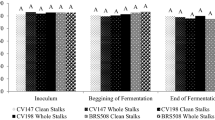Abstract
Biohydrogen production using agro-industrial by-products has considerable practical importance. Sweet sorghum is an ideal feedstock for biofuel production in the semi-arid and arid climatic regions. In the present investigation, the juice of SSV 74, a sweet sorghum variety, was examined as a novel substrate for biohydrogen production. The impact of medium pH, substrate, inoculum level and incubation temperature were analyzed at individual and interactive levels on biohydrogen production. Substrate level concentration and pH of the fermentation medium played a critical role on overall biohydrogen production at individual level, and indicated >90 % influence on product yield. On the other hand at interactive level; pH of the fermentation medium, inoculum and substrate concentrations revealed maximum severity index of 78 % (43 % for medium pH vs inoculum concentration and 35 % for inoculum vs substrate concentration). Overall, biohydrogen production yield was enhanced from 283 to 546 mL/3.25 g glucose equivalents of juice upon statistical optimization leading to a >190 % of H2 yield. Along with the H2 production, various acid intermediates were produced with acetate in maximum concentration indicating the occurence of acetogenic fermentation.


Similar content being viewed by others
References
Antonopoulou, G., H.N. Gavala, I.V. Skiadas, and G. Lyberatos. 2010. Influence of pH on fermentative hydrogen production from sweet sorghum extract. International Journal of Hydrogen Energy 35: 1921–1928.
Antonopoulou, G., H.N. Gavala, I.V. Skiadas, and G. Lyberatos. 2011. Effect of substrate concentration on fermentative hydrogen production from sweet sorghum extract. International Journal of Hydrogen Energy 36: 4843–4851.
APHA, Awwa, and WPCE. 1995. Standard methods for examination of water and wastewater, 18th ed. Washington, DC: American Pubilc Health Assoiation.
Ariyajaroenwong, P., P. Laopaiboon, and L. Laopaiboon. 2012. Repeated-batch ethanol production from sweet sorghum Juice by Saccharomyces cerevisiae immobilized on sweet sorghum stalks. Energies 5: 1215–1228.
Billa, E., D.P. Koullas, B. Monties, and E.G. Koukios. 1997. Structure and composition of sweet sorghum stalk components. Industrial Crops and Products 6(3–4): 297–302.
Cohen, A., J.M. Van Gemert, R.J. Zeotemeyer, and A.M. Breure. 1984. Main characteristics and stoichiometric aspects of acidogenesis of soluble carbohydrate containing waste waters. Process Biochemistry 19: 228–232.
Cunningham, R.L., K.D. Carlson, and M.O. Bagby. 1988. Extracted sweet sorghum substrates as a source of fermentable sugars. Applied Biochemistry and Biotechnology 17(1–3): 117–124.
Directorate of Sorghum Research—Annual Report 2010–2011. Comparision of sugar accumulation in different sorghums. 2010–2011: 50–51. www.sorghum.res.in/annual_report/ar10-11.pdf.
Lee, D.J., K.Y. Show, and A. Su. 2011. Dark fermentation on biohydrogen production: pure culture. Bioresource Technology 102: 8393–8402.
Mamma, D., P. Christakopoulos, D. Koullas, D. Kekos, B.J. Macris, and E. Koukios. 1995. An alternative approach to the bioconversion of sweet sorghum carbohydrates to ethanol. Biomass and Bioenergy 8(2): 99–103.
Owen, W.F., D.C. Stuckey, J.B. Jr Healy, L.Y. Young, and P.L. Mc Carty. 1979. Bioassay for monitoring biochemical methane potential and anaerobic toxicity. Water Research 13: 485–493.
Prakasham, R.S., P. Brahmaiah, and T. Satish. 2009a. Fermentative biohydrogen production by mixed anaerobic consortia: impact of glucose to xylose ratio. International Journal of Hydrogen Energy 34: 9354–9361.
Prakasham, R.S., T. Sathish, P. Brahmaiah, Ch. Subba Rao, R. Sreenivasrao, and P.J. Hobbs. 2009b. Biohydrogen production from renewable agri-waste blend: optimization using mixer design. International Journal of Hydrogen Energy 34: 6143–6148.
Prakasham, R.S., T. Sathish, and P. Brahmaiah. 2010. Biohydrogen production process optimization using anaerobic mixed microbial consortia: a prelude study for use of agro-industrial material hydrolysate as substrate. Bioresource Technology 101: 5708–5711.
Prakasham, R.S., Ch. SubbaRao, R. Srinivasa Rao, G. Suvarna Lakshmi, and P.N. Sarma. 2007. L-Asparaginase production by isolated Staphylococcus sp. 6A: design of experiment considering interaction effect for process parameter optimization. Journal of Applied Microbiology 102: 1382–1391.
Saraphirom, P., and A. Reungsang. 2010. Optimization of biohydrogen production from sweet sorghum syrup using statistical methods. International Journal of Hydrogen Energy 35: 13435–13444.
Semra, T., U. Davut, and I.T. Engine. 1995. The potential use of sweet sorghum as a non polluting source of energy. Energy 22: 17–19.
Sreenivasrao, R., P. Ch. Jyothi, R.S. Prakasham, P.N. Sarma, and L. Venkateswar Rao. 2006. Xylitol production from corn fiber and sugarcane bagasse hydrolysates by Candida tropicalis. Bioresource Technology 97: 1974–1978.
Sreenivasrao, S., R.S. Prakasham, K. Krishna Prasad, S. Rajesham, P.N. Sarma, and L. Venkateswar Rao. 2004. Xylitol production by Candida sp.: parameter optimization using Taguchi approach. Process Biochemistry 39: 951–956.
Srinivasa Rao, P., and C. Ganesh Kumar (eds.). 2013. Characterization of tropical sweet sorghum cultivars. Berlin: Springer.
Suvarna Lakshmi, G., Ch. Subba Rao, R. Sreenivasrao, P.J. Hobbs, and R.S. Prakasham. 2009. Enhanced production of xylanase by a newly isolated Aspergillus terreus under solid state fermentation using palm industrial waste: a statistical optimization. Biochemical Engineering Journal 48: 51–57.
Turker, L., S. Gumus, and A. Tapan. 2008. Biohydrogen production molecular aspects. Journal of Scientific and Industrial Research 67: 994–1016.
Wang, J., and W. Wan. 2009. Factors influencing fermentative hydrogen production: a review. International Journal of Hydrogen Energy 34: 799–811.
Worley, J.W., D.H. Vaughan, and J.S. Cundiff. 1992. Energy analysis of ethanol production from sweet sorghum. Bioresource Technology 40(3): 263–273.
Acknowledgments
The authors are grateful to The Director of Indian Institute of Chemical Technology, Hyderabad, India. One of the authors, D Nagaiah acknowledges CSIR for financial support in the form of Senior Research Fellowship.
Author information
Authors and Affiliations
Corresponding author
Rights and permissions
About this article
Cite this article
Nagaiah, D., Prakasham, R.S., Umakanth, A.V. et al. Sweet Sorghum Juice as an Alternate Substrate for Fermentative Hydrogen Production: Evaluation of Influencing Parameters Using DOE Statistical Approach. Sugar Tech 15, 338–344 (2013). https://doi.org/10.1007/s12355-013-0223-z
Received:
Accepted:
Published:
Issue Date:
DOI: https://doi.org/10.1007/s12355-013-0223-z




